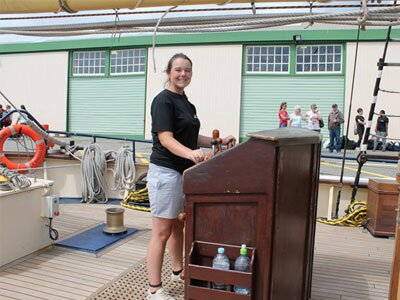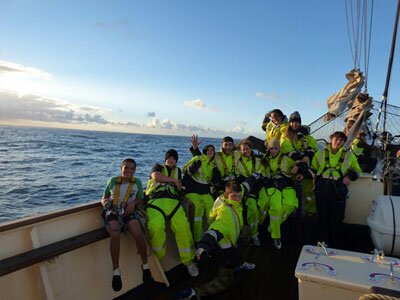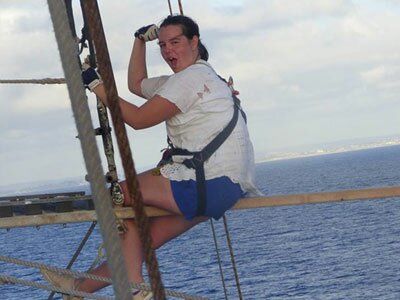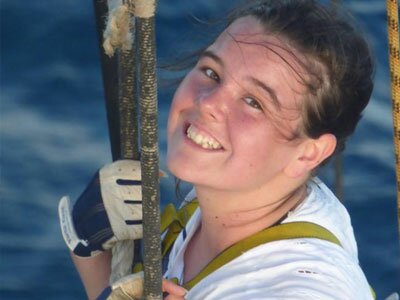
Maddison Walsh is 17 years old and has been developed as a leader at the Drug Aware Ignite program for the last two years. This March, in partnership with the Department of Sport and Recreation, Maddison (along with Drug Aware Ignite participant William Krakouer) was gifted a scholarship of a voyage aboard the Leeuwin tall ship for 6 days, working with 30 other young people from across WA.
How did you feel when you first heard you were going to go on the Leeuwin for a week?
Nervous and excited. I was unsure of how I would go with a bunch of people I didn’t know. I had never on a sailing ship or on a boat for that long at sea.
Where did the ship sail to? Describe the entire Itinerary.
Due to impending rough weather warnings, (cyclone threat from the Exmouth area), the Captain had to keep us close to the coast. We would have only spent a day and a half at sea where we couldn’t see land. We sailed between Rottnest Island and the coast off Yanchep. Despite the bad weather warnings the swell did not get above 2 metres.
Describe how you felt when you first saw the ship and met your crew mates? What was the ship like?
When I first saw the ship it was like a smack in the face with the fact that I would be on a boat for 6 days away from home. Leeuwin is very deceptive, there was a lot more room below deck than I had imagined. The group of 30 trainees were split into 3 groups, watches. When I was put into my watch group I met the 9 people I would be living and working with. I was concerned about possible classes between the personalities.
What were your fears of being on a boat for 6 days with people you didn’t know?
I was concerned that I would not get along with my shipmates and the 6 days would seem like an eternity.
Its Day 1 and you’ve just set off – describe what everyone needed to do as part of the crew
On day 1 after doing a series of ice breaker and get-to-know everybody games with the watch we were spoon-fed instructions on how to set the sails as we left the port.
What were your sleeping quarters, eating and shower facilities like?
Below deck was the main saloon, (the eating area), the galley, the cabins, toilets and showers. Everything seemed to be squished together as if the main idea was to invade everybody’s personal space. Surprisingly we all had bunks of some kind, instead of hammocks, which I was expecting. Because of the limited amount of fresh water showers were limited to 2 minutes per person. This felt like hell to me as I prefer half an hour! We did at least have hot water.

What were your daily duties?
Morning started at 6.30am to 7am. Depending upon the day’s activities. We were to head-up on-deck for morning exercises and stretches before watches were sent for breakfast. After breakfast it was happy-hour. This was cleaning time. Watches were given a station to clean. These were; after-accommodation and main saloon (crew sleeping quarters and eating area); Forward-accommodation (trainee sleeping quarters and bathrooms); the decking area. After this completed the Captain issued the days main activities. These included; sailing and boat knowledge activities.
What did you find most difficult?
Apart from being sea-sick for 2 days I found the most difficult thing to do was climbing the square and going out on the yards to handle the sails.
What were you best at?
I conquered knowing the different ropes and their workings. I felt that after 3 days I knew all of the ropes like the back of my hand.
How did everyone get on together? Were there any problems?
Just like any situation not everybody gets along. There were a number of people who “butted heads” they all managed to get along until the second last day where some started to get a bit moody.

Describe the challenge of climbing the mast – how tall was it? What made it scary? Were you thinking you might not do it?
The main problem with climbing the main mast was that the boat was rocking because of the waves. The further you went up the mast the more pronounced this became and the ropes you were climbing on became narrower and steeper. There was no point did I think I couldn’t climb the main mast because I hadn’t spent 2 days sea-sick and the sponsor spend a large amount of money on me not to climb the horrible tall thing (33 metres) and read the plaque.
When did the seasickness start and how did everyone cope?
Most trainees got sea-sick on the third or fourth day. This was mainly caused by the 2 metre swell. Most were over it within 2 days. Unfortunately there were a few who seemed to be sick the whole voyage. When sea-sickness hit everyone clipped themselves to the side rail and didn’t move unless to lie on the deck to sleep, or to feel like dying. There were a few lucky people who didn’t get sick, even some of the crew were affected.
What were the night watches like?
Night watches were in 4 hour slots. If you were sailing this consisted of bow watch, someone at the helm and bilge watch. If we were not sailing watches were a little different because not everybody was required at once. The watch was further split into 1 hour slots where only 2 or 3 people were required for the hour. Whilst anchored there was no need for people at the helm or bow. Watches were responsible for monitoring and recording, wind speed and direction, barograph, range of other vessels depth and lights. Bilge watch was still required.

Did you see any wildlife?
We saw dolphins at the port. During night watch we saw glowing plankton. During one of the night watches we saw hundreds of baby eel-like creatures about twenty centimetres in length. Not sure if they were eels or snakes? The crew managed to catch 3 tuna, two undersize which were returned to the ocean and one went into the freezer.
What was your lowest part?
Sea sickness was the lowest part of the trip. Feeling like death for 2 days sucks! Felt better after a day on Rottnest Island sleeping and swimming.
What was your highest moment?
I felt my highest moment was when I was voted watch leader for our take-over day. I successfully lead my team on the day.

Describe coming back into port…
Coming back to port couldn’t have taken longer if it had tried due to waiting for a large car-carrier to leave harbour. As we were berthed at Fremantle it didn’t seem that we had been at sea for 6 days. A little bit of me did not want to leave because the last 3 days of the trip were great. The rest of me really wanted to go home, to see my family and dog. I was also looking forward to a bed that didn’t rock and have waves crashing against it, and a nice long shower where you didn’t feel like falling over.
What have you learned going on this trip?
I have learned the name and function of a ridiculous number of ropes and sheets. But most importantly, I learnt that just because something starts not as expected, perseverance, patience and a brighter way of thinking can turn things all around.
How can you use what you’ve learned within the Ignite program?
I have learnt new life skills which I can’t exactly put into words but I know will assist me in my duties at Ignite.
How can you use that in your life and career?
Throughout life you will come across a variety of people that you may or may not get on with too well. This life experience will help me overcome the differences between people and allow for the job in hand to be done without conflict.
Would you recommend the trip to others?
I would most definitely recommend this trip for those who like an adventure, lack confidence in themselves, want new life skills and experience, make new friends and increase leadership skills.
- Maddison Walsh